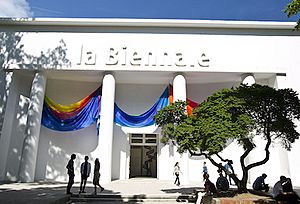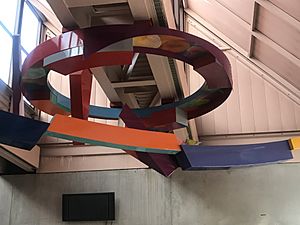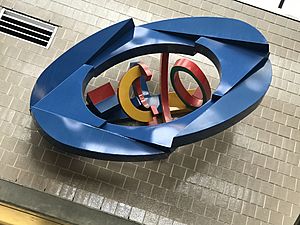Sam Gilliam facts for kids
Quick facts for kids
Sam Gilliam
|
|
|---|---|
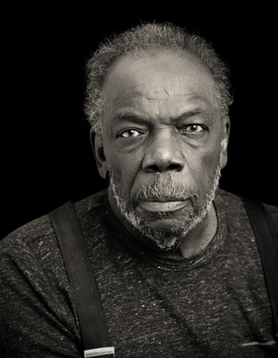
by Fredrik Nilsen Studio
|
|
| Born | November 30, 1933 Tupelo, Mississippi, U.S.
|
| Died | June 25, 2022 (aged 88) Washington, D.C., U.S.
|
| Alma mater | University of Louisville |
| Known for | Painting |
|
Notable work
|
Double Merge (Carousel I and Carousel II) (1968) Seahorses (1975) Yves Klein Blue (2017) |
| Movement | Washington Color School |
| Spouse(s) |
|
Sam Gilliam (ghil-EE-əm; November 30, 1933 – June 25, 2022) was an American artist. He was known for his unique abstract paintings. Gilliam was a color field painter and a lyrical abstractionist. This means he used large areas of color and expressive brushstrokes.
He was part of the Washington Color School. This group of artists in Washington, D.C., created abstract art. They worked in the 1950s and 1960s. Gilliam's art is also called abstract expressionism.
A big part of his art involved using canvas in new ways. He worked with canvas that was stretched, draped, or wrapped. He also added three-dimensional parts to his art. Around 1965, he became the first artist to hang painted canvas without a frame. This was a major new idea in art. It had a lasting impact on modern art.
Later in his career, Gilliam used many different materials. These included polypropylene, computer-generated images, and metallic paints. He also used handmade paper, aluminum, steel, plywood, and plastic.
Contents
Who Was Sam Gilliam?
Sam Gilliam was born in Tupelo, Mississippi, on November 30, 1933. He was the seventh of eight children. His family moved to Louisville, Kentucky, soon after he was born. His father worked on the railroad. His mother took care of their large family.
When he was young, Gilliam wanted to be a cartoonist. He spent a lot of time drawing. He went to Central High School in Louisville. He graduated in 1951.
Sam Gilliam's Education and Early Career
After high school, Gilliam went to the University of Louisville. He earned his bachelor's degree in fine arts in 1955. He was one of the first Black students to attend the university. In the same year, he had his first art show there.
From 1956 to 1958, Gilliam served in the United States Army. He returned to the University of Louisville in 1961. He earned his master's degree in painting. His professor advised him to become a high school art teacher. He taught art at McKinley High School in Washington, D.C.
In 1962, Gilliam moved to Washington, D.C. He married Dorothy Butler. She was a reporter for The Washington Post. She was also the first African American female reporter at the newspaper. Later, Gilliam married Annie Gawlak in 2018. They had been partners for 35 years.
How Did Sam Gilliam's Art Style Change?

During the 1960s, there were many social changes in the United States. Gilliam started making abstract art that made strong statements. His art was inspired by the experiences of African Americans. Some people thought abstract art was not important for Black life. But Gilliam believed it was.
His early style changed from dark, figure-based art. It became large paintings with flat colors. He then took away the traditional frame for his canvases. This led to his most famous works. He would drape and hang large, color-stained canvases from walls and ceilings.
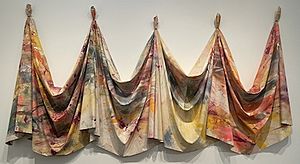
Gilliam was influenced by many artists. These included German Expressionists like Emil Nolde and Paul Klee. He also learned from American artists like Morris Louis and Kenneth Noland. He found ideas from Vladimir Tatlin, Frank Stella, and Pablo Picasso.
In 1963, artist Thomas Downing introduced Gilliam to the Washington Color School. Around 1965, Gilliam started using unsupported canvases. He got the idea from seeing laundry hanging outside his studio. His draped paintings hung from ceilings or were placed on walls or floors. This made them like sculptures.
Gilliam said his paintings were about the art being in real space. He liked how powerful this was. His draped canvases looked different in every place they were shown. He often added metal, rocks, and wood to them. He became known as the "father of the draped canvas." One of his largest works in this style was Seahorses (1975). It was made for the Philadelphia Museum of Art.

In the 1960s, Gilliam also tried beveled-edge paintings. He painted over the edges of the canvas onto the frames. These paintings also mixed sculpture and painting. They kept his focus on abstract art.
In 1972, Gilliam represented the United States at the 36th Venice Biennale. This is a big international art show. His draped canvas Baroque Cascade (1968) was shown there. It was a huge artwork, over 75 feet long. Gilliam was the first African-American artist to show at the Biennale for the United States.
Sam Gilliam's Art in the 1970s and 1980s
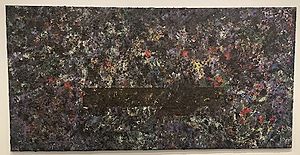
In 1975, Gilliam stopped making draped canvases. He was inspired by jazz musicians like Miles Davis. He started making geometric collages. He called them "Black Paintings" because they used shades of black. Works like Rail (1977) show this style. They have thick black paint and sharp geometric shapes.

In the 1980s, Gilliam's style changed again. He started making paintings that looked like African patchwork quilts. He used an improvisational approach. These works often had many canvases cut into shapes. They were then put together into one piece. His Wild Goose Chase series shows this change.
Sam Gilliam's Later Career and Recognition
In the late 1980s and 1990s, Gilliam was not as well-known in the art world. He showed his work mostly in Washington, D.C. This was partly because he wanted to work in his own community. Also, art critics and museums in New York showed less interest. Even so, he kept making new forms of paintings. He experimented with metal and washi paper.
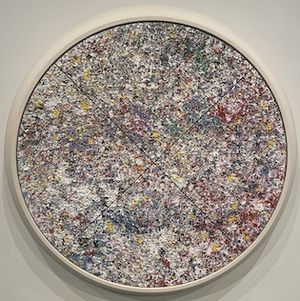
Starting in the 2000s, Gilliam's career became very popular again. His first big show was at the Corcoran Gallery in 2005. In 2012, a gallery owner from Los Angeles visited him. He offered to show Gilliam's work. This helped place his art in major museums like the Museum of Modern Art.
Gilliam had many important solo and group shows in the 2000s and 2010s. He showed his work at the Venice Biennale again in 2017. His work Yves Klein Blue (2017) was a large draped painting. It hung outside the entrance of the show. His first European show was in 2018 in Switzerland. In 2019, he joined Pace Gallery, a major New York gallery.
In 2022, a month before he passed away, he showed new circular paintings. These were called tondo paintings. They were shown at the Hirshhorn Museum and Sculpture Garden. These abstract paintings had circular canvases with beveled frames. This was a return to a style he used in the 1960s. This show, Sam Gilliam: Full Circle, was his last during his lifetime.
Sam Gilliam's Awards and Honors
Sam Gilliam received many awards, grants, and honorary degrees. He earned eight honorary doctorates. He also received the Kentucky Governor's Award in the Arts.
He got several grants from the National Endowment for the Arts. He also received a Guggenheim Fellowship. The Art Institute of Chicago gave him the Norman W. Harris Prize. He was named the 2006 University of Louisville Alumnus of the Year.
In 1987, the Smithsonian Institution asked Gilliam to create a print. It was to celebrate the opening of the S. Dillon Ripley Center. He made In Celebration, a colorful print. In 2009, he made another print called Museum Moment.
In 2003, Gilliam's work Matrix Red-Matrix Blue was installed at Rutgers Law School. In 2011, his work From a Model to a Rainbow was placed in the Washington Metro Underpass.
In 2015, Gilliam received the Medal of Art from the U.S. State Department. This was for his work in cultural diplomacy. His art was shown in embassies in over 20 countries.
In 2016, Gilliam created a piece for the opening of the National Museum of African American History and Culture. His 2019 show at Dia:Beacon featured his "innovative, loosely draped work."
Sam Gilliam's Family Life
In 1962, Sam Gilliam married Dorothy Butler. She was from Louisville. They had three daughters: Stephanie, Melissa, and Leah. They also had three grandchildren. They later divorced.
After his divorce, he met Annie Gawlak. She owned an art gallery in Washington, D.C. They were together for 35 years before marrying in 2018.
Sam Gilliam passed away at his home in Washington, D.C., on June 25, 2022. He was 88 years old.
Sam Gilliam's Public Artworks
Solar Canopy (1986) is a large aluminum sculpture by Sam Gilliam. It is 34 feet long, 12 feet wide, and 6 inches deep. It is located at York College, City University of New York. The sculpture hangs from the ceiling.
It is made of painted geometric shapes. Many vibrant colors are used. Some parts are solid colors, while others have a tie-dye effect. The artwork is connected horizontally and diagonally. There is a circular shape in the middle. The circle is red on the outside. Underneath, it has many tie-dye colors. Small blocks painted in red, orange, blue, and yellow hang below it. Some of these blocks have triangular shapes attached.
Jamaica Center Station Riders, Blue (1991) is a large aluminum sculpture. It is located at the Jamaica Center train station in New York. It is mounted high on a wall outside one of the entrances. The Metropolitan Transportation Authority asked Gilliam to create this work.
The sculpture is made of geometric shapes. They are painted in solid primary colors (red, yellow, blue). The overall shape is circular. The outer part is blue, and the inner parts are red and yellow. Gilliam said the work reminds him of "movement, circuits, speed, technology, and passenger ships." He added that the blue color gives a solid visual in a busy area.
Sam Gilliam's Exhibitions
Sam Gilliam had many solo shows in the United States and other countries. Some of his solo shows include:
- Paintings by Sam Gilliam (1967) at The Phillips Collection, Washington, D.C.
- Projects: Sam Gilliam (1971) at the Museum of Modern Art, New York.
- Sam Gilliam: A Retrospective (2005–2007) at the Corcoran Gallery of Art, Washington, D.C.
- Sam Gilliam: The Music of Color (2018) at Kunstmuseum Basel, Switzerland. This was his first solo museum show in Europe.
After joining Pace Gallery in 2019, he had several quick solo shows. These included Existed Existing (2020) in New York. He also had his first solo shows in Asia in Seoul and Hong Kong in 2021.
A major show, Sam Gilliam: Full Circle, opened in May 2022. It was at the Hirshhorn Museum and Sculpture Garden. This show featured works he made during the COVID-19 pandemic. It was his last show before he passed away.
His first show after his death, Late Paintings, opened in London in October 2022. This was a show Gilliam had planned himself.
He also took part in many group exhibitions. These included:
- The De Luxe Show (1971) in Houston.
- The 36th Venice Biennale (1972).
- The Marrakech Biennale (2016).
- The 57th Venice Biennale (2017).
Where to See Sam Gilliam's Art
- Long Green (1965), Anacostia Community Museum, Smithsonian Institution, Washington, D.C.
- Shoot Six (1965), National Gallery of Art, Washington, D.C.
- They Sail (1966), The Phillips Collection, Washington, D.C.
- Red Petals (1967), The Phillips Collection, Washington, D.C.
- Carousel State (1968), Metropolitan Museum of Art, New York
- Double Merge (Carousel I and Carousel II) (1968), Museum of Fine Arts, Houston, and Dia Art Foundation, New York (jointly owned)
- Relative (1968), National Gallery of Art, Washington, D.C.
- Restore (1968), Speed Art Museum, Louisville, Kentucky
- 10/27/69 (1969), Museum of Modern Art, New York
- April 4 (1969), Smithsonian American Art Museum, Smithsonian Institution, Washington, D.C.
- Dakar I (1969), Philadelphia Museum of Art
- Green April (1969), Kunstmuseum Basel, Switzerland
- Light Depth (1969), Hirshhorn Museum and Sculpture Garden, Smithsonian Institution, Washington, D.C.
- Swing (1969), Smithsonian American Art Museum, Smithsonian Institution, Washington, D.C.
- Basque 1 Range (1970), Pérez Art Museum Miami
- Change (1970), Mumok, Vienna, Austria
- Leaf (1970), Dallas Museum of Art
- Simmering (1970), Tate, London
- Carousel Merge (1971), Walker Art Center, Minneapolis
- Carousel Merge 2 (1971), Milwaukee Art Museum
- Day Tripper (1971), Carnegie Museum of Art, Pittsburgh
- Rondo (1971), Kunstmuseum Basel, Switzerland
- Wide Narrow (1972), Rose Art Museum, Waltham, Massachusetts
- "A" and the Carpenter I (1973), Art Institute of Chicago
- N°1 D (1977), Musée d'Art Moderne de Paris
- Rail (1977), Hirshhorn Museum and Sculpture Garden, Smithsonian Institution, Washington, D.C.
- Eiler Blues (1978), Madison Museum of Contemporary Art, Wisconsin
- Untitled (Black) (1978), Whitney Museum, New York
- Triple Variants (1979), Richard B. Russell Federal Building, Atlanta (General Services Administration)
- The Arc Maker I & II (1981), Detroit Institute of Arts
- Master Builder Pieces and Eagles (1981), Studio Museum in Harlem, New York
- Red & Black (1981), Indianapolis Museum of Art
- To Braque for Mantelpieces (1982), Cleveland Museum of Art
- Sculpture with a D (1980-1983), Davis station, Massachusetts Bay Transportation Authority, Boston
- Solar Canopy (1986), York College, City University of New York
- Purple Antelope Space Squeeze (1987), Milwaukee Art Museum
- Aviation Studies (1990), Louisiana Museum of Modern Art, Humlebæk, Denmark
- The Petition (1990), Smithsonian American Art Museum, Smithsonian Institution, Washington, D.C.
- Jamaica Center Station Riders, Blue (1991), Jamaica Center–Parsons/Archer station, Metropolitan Transportation Authority, New York
- Daily Red (1998), Anacostia Community Museum, Smithsonian Institution, Washington, D.C.
- Graining (1998), Kreeger Museum, Washington, D.C.
- Chair Key (2002), Philander Smith College, Little Rock, Arkansas
- Blue (2009), Pennsylvania Academy of the Fine Arts, Philadelphia
- From Model to Rainbow (2011), Takoma station, Washington Metropolitan Area Transit Authority
- Yet Do I Marvel (Countee Cullen) (2016), National Museum of African American History and Culture, Smithsonian Institution, Washington, D.C.


